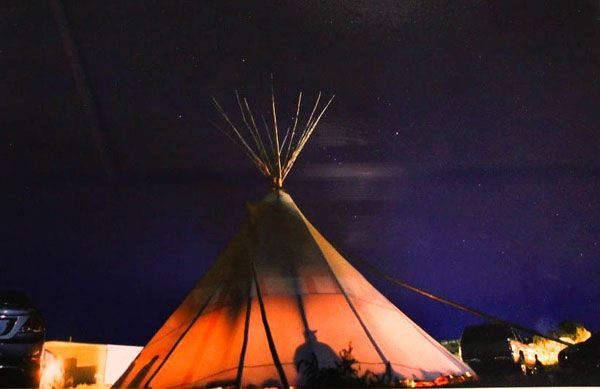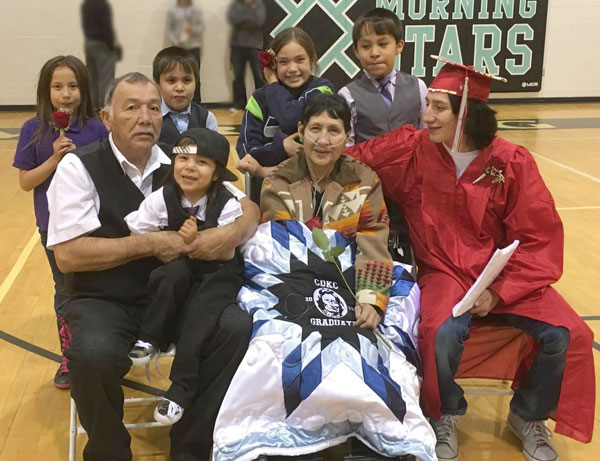 |
Canku Ota
|
 |
|
(Many Paths)
|
||
|
An Online Newsletter
Celebrating Native America
|
||
|
October 2016 - Volume
14 Number 10
|
||
|
|
||
|
Nahkohenexahe: The
Remarkable Story Of Henry Littlewhiteman, As Told By Eugene Limpy
|
||
|
by Gail Small - Tribal
College Journal of American Indian Higher Education
|
||
Editor’s Note: On May 11, 2016, Eugene Limpy recounted this story of volunteerism to Gail Small. This oral history supplements Small’s essay, “Ve’stahe’m Among the Northern Cheyenne.” There was a big man, he stood about 6’3,” from the Rosebud Creek with broad shoulders and he was a hard worker. His name was Henry Littlewhiteman and his Cheyenne name was Nahkohenexahe (Bear Orphan). He was my grandpa. He had two brothers, James and Peter. Both of them were hard workers too. Peter could not hear, since a rattlesnake bite took his hearing away when he just a kid, but he could do sign talk. My grandpa never went into Sundance. He was strictly a faster. He fasted on the Red Hill behind his place. He was a strong medicine man. He had a medicine bundle and he doctored people. The vision my grandpa got was to take care of his people. He took this message very seriously and he lived his life around that. People back then took Cheyenne ceremonies very seriously and they walked their talk. Henry Littlewhiteman decided that the people who lived along the Rosebud Creek needed a place to come together. It is a pretty isolated area of the reservation. He told his brothers that he was going to build a big log house for the Ree District and that it would become the community hall. Sometimes his brothers helped him but most of the time it was just him. He would haul the logs in from the hills with horses. It took a few years but he must have got it all built in the early 1940’s because it had already been built for about five years when I was born. Henry built that whole community hall without asking for money or anything. I guess that is what they call volunteer labor today. The hall had two big potbelly woodstoves that kept it warm. Grandpa would haul wood in on a team and wagon from the hills and pile big stacks of firewood around the hall. And he built long tables for use inside of the hall. Grandpa would even haul coal in from the creek above Old Roman Nose’s house. They used the coal to keep the hall warm. The log hall was the center of many good times along the Rosebud Creek. People from all over came to attend the “Indian dances,” Onehanotaxevesanestotse (dressing for a war dance). They also came for the hand games, card games, bingos, and giveaways. Anything the people wanted to celebrate, they did there. Veterans Day was one of the bigger gatherings at this hall because we really honor the veterans. People would leave their tent poles in the ground around the hall all year long, so that when they came back they could put their canvas tents right up. Those days they even had stove pipes in their tents for their stoves and it was like a home. There would sometimes be two feet of snow there, and people would be riding in on their horses and pulling in on their wagons to set up camp. My grandpa would have their firewood and coal already there for them. People would camp around the hall for two weeks, sometimes longer, during Christmas and New Year’s. They came on horseback or team and wagon from as far as Birney and Ashland—that’s about 20 miles each way. My grandpa even used to have food waiting for the people. He got along with the ranchers pretty good, and those days we only had White ranchers here. My grandpa would get Burton Brewster to donate a cow for the Christmas feast—that way they had a lot of meat for the holidays. When people got there they knew my grandpa had things set up and ready for their visit. Charlie Whitedirt’s family, Ray Harris’s family, the Killsnights, Flyings, Henry Sioux—many of these families and others from the different districts—all came in and camped for the holidays. Christmas was a special holiday for my grandpa. I remember going out into the hills with him on his horse and sleigh below the red hills. He would go up to a big cedar tree and talk to that tree like a person: “It’s that time of year again, I come for one of your brothers. We are going to put him in the dancehall.” He would actually ask for permission to cut down the cedar tree. I heard him. He would put the big cedar tree in the dancehall and it made the whole place smell good. Behind the cedar tree he would hang Chief Two Moon’s flag from the Custer battle. I always remember how it all looked—pretty special. The people liked to play all kind of games. They used to bet blankets or material or whatever they had in the stick games, bingo, and card games. I remember the women used to move all the tables into the middle of the hall and they would race each other around the tables carrying a spoon with an egg on it. That was the time they all wore shawls, so seeing them running around like that was a funny sight. They even had a game that whoever ate the most crackers and then whistled won. It was funny to watch too. They knew how to have fun in those days when there was no TV, and there was no alcohol or drugs. My grandpa always had one gift for each of his grandkids. I think back now and know how important that was. My grandpa would watch us and it seemed like he knew what we would become as we grew up. For instance, I used to roll socks into a ball and use a wire hoop to play basketball. The gift I got from my grandpa was a little basketball one year. Those prayers and what they saw in you, they worked. Look at my life, how basketball became such a big part of my life and it took me all over the world. My grandpa taught us many good things. There were usually 12 of us grandkids with him. He took us all with him to cut poles, hunt, garden, and we learned how to work. He would put up a sweat in the middle of winter and dig a hole in the creek for us grandkids to jump into. He told us that it would help us not to get sick, and to this day I hardly get sick. My grandpa built three log houses for his family. But one of them was always open for those people who didn’t have a place to live. He kept that extra house for them. Like I said, his vision was to take care of the people and he did. My grandpa was also the drum keeper along the Rosebud. That is a role that is dying out. The drum that we sing with is sacred. In those days, our people were self-sufficient. Like my grandpa, he never asked for anything like money. He just did it. It was the old people’s ways to help each other out. Nobody had welfare in them days. No matter how cold it was, they went outside and worked every day, [they] hunted, hauled wood and water, or whatever to get by. They had pride in themselves. My name is Magpie Red, Mo’e’ha Ma’etahtse. I was named after a Cheyenne Arapaho on my father’s side. His name was White Antelope and he was from the Wind River reservation in Wyoming. He got the name after the Great Race story. Remember the magpie who won the race—the buffalo was running so hard that he was blowing out some blood. So when the magpie would swoop down and back up again, he got little sprinkles of blood from the buffalo on him. But he won the race for us, so that is my name. Enohta’hane.
|
||||
|
|
|
|
||
|
|
||
| Canku Ota is a free Newsletter celebrating Native America, its traditions and accomplishments . We do not provide subscriber or visitor names to anyone. Some articles presented in Canku Ota may contain copyright material. We have received appropriate permissions for republishing any articles. Material appearing here is distributed without profit or monetary gain to those who have expressed an interest. This is in accordance with Title 17 U.S.C. Section 107. | ||
|
Canku Ota is a copyright ©
2000 - 2016 of Vicki Williams Barry and Paul Barry.
|
||
 |
 |
|
|
The "Canku
Ota - A Newsletter Celebrating Native America" web site and
its design is the
|
||
|
Copyright ©
1999 - 2016 of Paul C. Barry.
|
||
|
All Rights Reserved.
|
||

